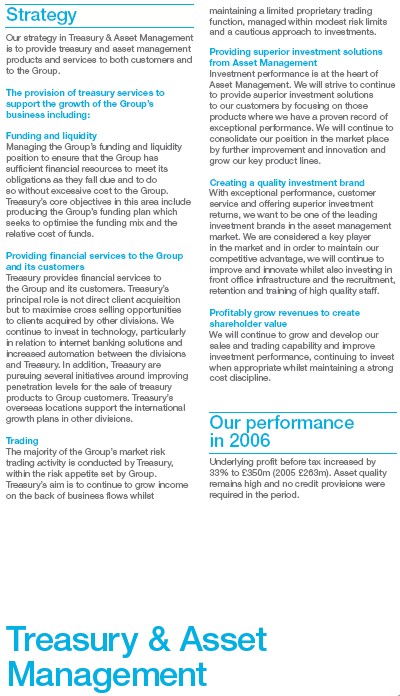There's a simple rule in finance. It says don't mix your money with the customers. So I was surprised to read the HBOS 2006 result which on page 6 says this of one of its divisions

Let's put this in plain English. Treasury manages HBOS's money. Asset management manages client money. But you'll note they're one division. To put it bluntly, I don't think that should happen. I was curious, so I went to page 72 where I found this summary of this division's performance (which is bigger in the original if you have difficulty reading it):

This did nothing to allay my fears. The division:
provide[s] treasury and asset management products and services to both customers and to the Group.
Oh well, you think, there must be clear indications of good Chinese Walls in that case. But no, you get comments like this:
Treasury provides financial services to the Group and its customers. Treasury's principal role is not direct client acquisition but to maximise cross selling opportunities to clients acquired by other divisions.
I added the emphasis, because since when did keeping you own money as far away as possible from the client's create a "cross selling opportunity"? Accountancy got into a mess because of "cross selling". Is banking now doing the same sort of thing?
And to what extent is the "cross selling" to do with the practice referred to on page 73?:
Approximately £21bn of funds were raised from existing programmes in the securitisation and covered bond markets during the year. This comprised approximately £6.5bn from covered bonds and approximately £14.5bn from securitisations. These transactions included a securitisation of Australian residential mortgages originated by BankWest and the first US Dollar mortgage backed covered bond issued into the United States.
I bet the owners of the last one are rubbing their hands with glee right now. I'd have loved to have been "cross sold" that. And remember, it's this sort of debt that pulled down Northern Rock.
It's all very odd. I can't see how a structure like this is consistent with good corporate governance so it's not a bank I'll be going near right now.
Thanks for reading this post.
You can share this post on social media of your choice by clicking these icons:
You can subscribe to this blog's daily email here.
And if you would like to support this blog you can, here:


